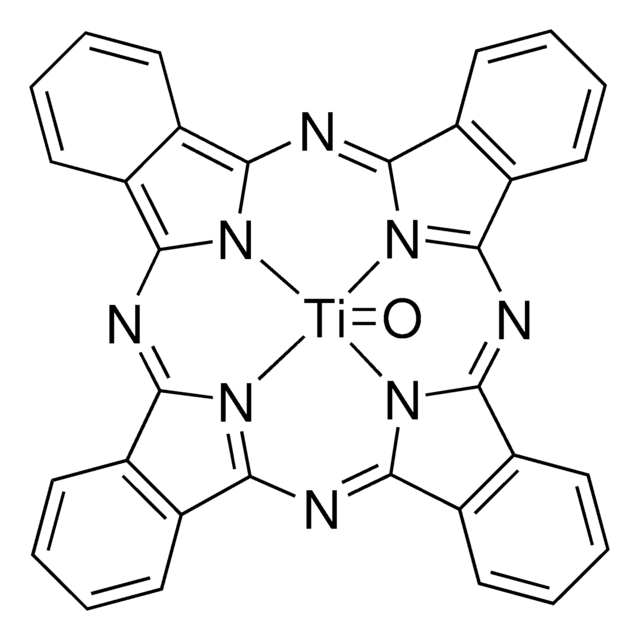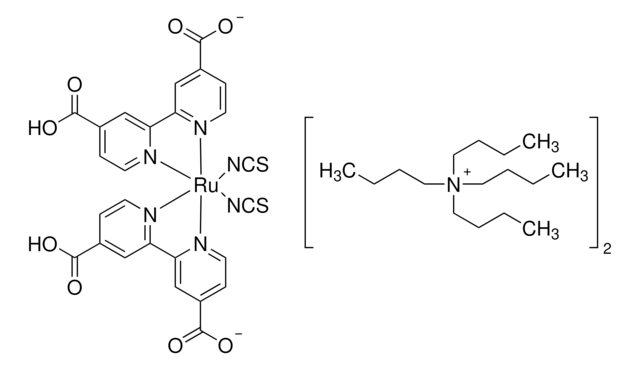Kluczowe dokumenty
791547
Titania paste, transparent
Synonim(y):
Greatcell Solar®, TiO2 paste
About This Item
Polecane produkty
opis
Crystal Structure: > 99% anatase (analysis carried out on starting material, prior to paste manufacture)
Poziom jakości
Formularz
paste (yellow)
stężenie
19.0 wt. %
śr. rozm. cząst.
20 nm (active)
lepkość
40000-55000 mPa.s(20 °C) (Analysis carried out at 20°C with 20mm 4 degree cone/plate; 40 s-1))
ciąg SMILES
[Ti](=O)=O
InChI
1S/2O.Ti
Klucz InChI
GWEVSGVZZGPLCZ-UHFFFAOYSA-N
Powiązane kategorie
Opis ogólny
Zastosowanie
Transparent Titania Paste is formulated to yield sintered film thicknesses of 6-7μm when screen printed with a 43T mesh. Transparent Titania Paste has highly dispersed and stable anatase nanoparticles.
It is optimised for screen printing using a synthetic 43T mesh screen (or similar). After drying; this paste must be fired at or above 500°C. This results in a transparent sintered layer; with a film thickness of approximately 6-7μm for one printed layer and ~12μm for two printed layers; when using a 43T mesh screen.
The paste exhibits optimal rheological properties that provide good surface uniformity and contains organic binders specially formulated to provide versatile porosity suitable for a range of dye/electrolyte systems.
Storage: Store in the dark at 20°C
Informacje prawne
Hasło ostrzegawcze
Warning
Zwroty wskazujące rodzaj zagrożenia
Zwroty wskazujące środki ostrożności
Klasyfikacja zagrożeń
Eye Irrit. 2 - Skin Irrit. 2
Kod klasy składowania
10 - Combustible liquids
Klasa zagrożenia wodnego (WGK)
WGK 1
Temperatura zapłonu (°F)
195.8 °F - closed cup
Temperatura zapłonu (°C)
91 °C - closed cup
Wybierz jedną z najnowszych wersji:
Masz już ten produkt?
Dokumenty związane z niedawno zakupionymi produktami zostały zamieszczone w Bibliotece dokumentów.
Klienci oglądali również te produkty
Produkty
Professor Shinar (Iowa State University, USA) summarizes the developments of a variety of sensor configurations based on organic and hybrid electronics, as low-cost, disposable, non-invasive, wearable bioelectronics for healthcare.
Kilka monowarstw osadzania warstw atomowych (ALD) na powierzchniach i interfejsach do zastosowań energetycznych
Few Monolayer Atomic Layer Deposition (ALD) on Surfaces and Interfaces for Energy Applications
Dye-sensitized solar cells (DSCs) are 3rd generation solar cells combining the promise of high efficiency with low production costs.
Global Trade Item Number
| SKU | GTIN |
|---|---|
| 791547-20G | 4061832949215 |
| 791547-10G | 4061832948799 |
Nasz zespół naukowców ma doświadczenie we wszystkich obszarach badań, w tym w naukach przyrodniczych, materiałoznawstwie, syntezie chemicznej, chromatografii, analityce i wielu innych dziedzinach.
Skontaktuj się z zespołem ds. pomocy technicznej







